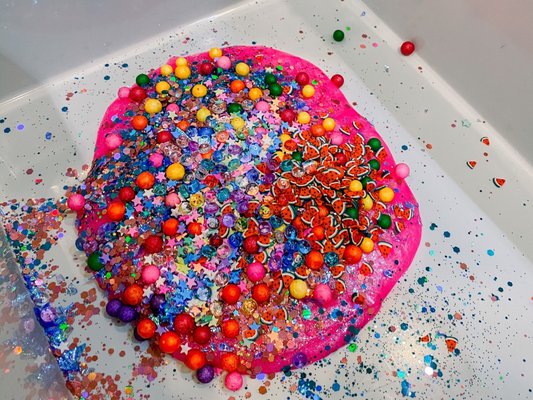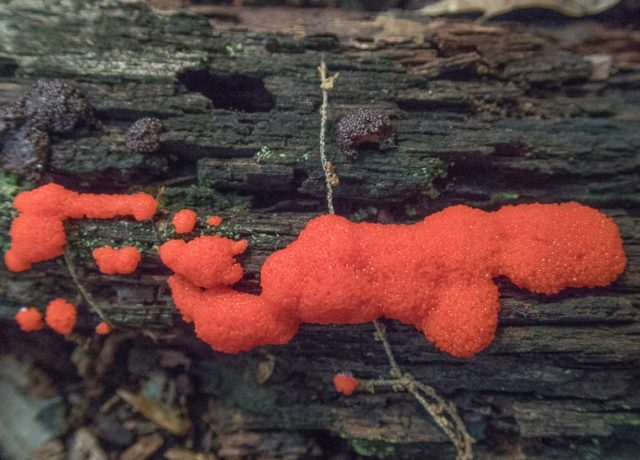Noticing a slimy, red substance in your kitchen sink can be a cause for concern. But what exactly is causing this annoying buildup? There are a few common culprits behind the red slime in your kitchen sink. One of the main causes is bacteria, specifically a type of bacteria called Serratia marcescens. This bacteria thrives in moist and warm environments, making your kitchen sink the perfect breeding ground. Another possible cause is iron bacteria, which can also produce a reddish slime in your sink. This type of bacteria feeds on iron in your water and can often be found in well water. Lastly, if you have hard water, the minerals in it can react with your cleaning products and create a red residue.1. Causes of Red Slime in Kitchen Sink
Now that you know what's causing that pesky red slime, it's time to get rid of it. The first step is to thoroughly clean your sink with hot water and soap. This will help remove any surface buildup and make it easier to tackle the deeper layers of slime. Next, mix equal parts of vinegar and water and use a cloth or sponge to scrub the affected areas. The acidity of vinegar can help break down the slime and kill any bacteria. If the red slime persists, try using a bleach solution to disinfect your sink. Mix 1 tablespoon of bleach with 1 gallon of water and use a cloth or sponge to scrub the sink. Make sure to rinse thoroughly afterwards. You can also try using a commercial cleaner specifically designed for removing bacteria and mold from sinks and drains.2. How to Get Rid of Red Slime in Kitchen Sink
Red slime and mold are often mistaken for each other, but they are actually two different things. Red slime is caused by bacteria, while mold is a type of fungus. The appearance of red slime is slimy and can vary in color from pink to dark red, while mold is often fuzzy and can be green, black, or white in color. Both can be harmful and should be dealt with promptly to prevent further growth and potential health hazards.3. Red Slime vs. Mold in Kitchen Sink
If you prefer to use natural products in your home, there are a few options for getting rid of red slime in your kitchen sink. One method is to sprinkle baking soda over the affected areas and then spray with vinegar. Let it sit for a few minutes before scrubbing and rinsing with hot water. You can also try using a paste of equal parts baking soda and water to scrub the sink. Another natural option is to use a mixture of lemon juice and salt to scrub the affected areas.4. Natural Remedies for Red Slime in Kitchen Sink
You may be wondering if the red slime in your kitchen sink is harmful to your health. While it may not be pleasant to look at, red slime is not typically harmful to humans. However, it can cause some health problems for those with weakened immune systems or respiratory issues. It's best to take preventative measures and keep your sink clean to avoid any potential health risks.5. Red Slime in Kitchen Sink: Is it Harmful?
The best way to deal with red slime in your kitchen sink is to prevent it from appearing in the first place. Regularly cleaning your sink with hot water and soap can help remove any potential bacteria buildup. You can also try using a disinfectant cleaner once a week to kill any remaining bacteria. Additionally, make sure to keep your sink and faucet dry after use to prevent moisture from building up.6. Preventing Red Slime Buildup in Kitchen Sink
There are a few common misconceptions when it comes to red slime in kitchen sinks. One of the biggest myths is that bleach will effectively get rid of it. While bleach can help kill bacteria, it may not fully remove the slime. Another misconception is that red slime is caused by dirty dishes or food particles. While these can contribute to the buildup, the main cause is bacteria growth in moist environments.7. Red Slime in Kitchen Sink: Common Misconceptions
If you prefer to make your own cleaning solutions, there are a few recipes you can try to get rid of red slime in your kitchen sink. One option is to mix equal parts of hydrogen peroxide and water and use it to scrub the affected areas. You can also try making a paste with borax and water to scrub the sink. Keep in mind that these solutions may not be as effective as commercial cleaners, but they can be a more natural alternative.8. DIY Cleaning Solutions for Red Slime in Kitchen Sink
Identifying and treating red slime in your kitchen sink is crucial for maintaining a clean and healthy environment. If you notice a reddish slime or residue in your sink, it's important to take action immediately. Use a combination of cleaning methods, such as hot water and soap, vinegar, and bleach, to effectively remove the slime and kill any bacteria. If the problem persists, consider contacting a professional cleaning service for a thorough and effective treatment.9. Red Slime in Kitchen Sink: How to Identify and Treat
If you've tried various cleaning methods but the red slime in your kitchen sink just won't budge, it may be time to call in the professionals. A cleaning service that specializes in mold and bacteria removal can effectively get rid of the red slime and prevent it from coming back. They may also be able to identify the root cause of the problem and provide solutions to prevent future buildup. Dealing with red slime in your kitchen sink can be a frustrating and unpleasant experience. However, with the right knowledge and cleaning methods, you can effectively get rid of it and prevent it from coming back. Regular maintenance and proper cleaning techniques can help keep your sink free from red slime and maintain a clean and healthy kitchen environment.10. Professional Services for Red Slime Removal in Kitchen Sink
Red Slime in Kitchen Sink: Causes and Solutions

What is Red Slime?
 Red slime, also known as red algae, is a type of bacteria that commonly grows in warm, damp environments. It can be found in various places in the home, including the kitchen sink. Red slime is typically slimy, red or pink in color, and can have a foul odor. It is not only unsightly, but it can also pose a health risk if left untreated.
Red slime, also known as red algae, is a type of bacteria that commonly grows in warm, damp environments. It can be found in various places in the home, including the kitchen sink. Red slime is typically slimy, red or pink in color, and can have a foul odor. It is not only unsightly, but it can also pose a health risk if left untreated.
What Causes Red Slime in the Kitchen Sink?
 Red slime is commonly found in kitchen sinks due to the moist and warm environment, as well as the presence of food particles. This bacteria thrives in these conditions and can quickly spread if not properly cleaned and maintained. Other contributing factors to red slime growth in the kitchen sink include poor ventilation, infrequent cleaning, and the use of harsh chemicals that can disrupt the balance of bacteria in the sink.
Red slime is commonly found in kitchen sinks due to the moist and warm environment, as well as the presence of food particles. This bacteria thrives in these conditions and can quickly spread if not properly cleaned and maintained. Other contributing factors to red slime growth in the kitchen sink include poor ventilation, infrequent cleaning, and the use of harsh chemicals that can disrupt the balance of bacteria in the sink.
How to Get Rid of Red Slime
 To effectively get rid of red slime in your kitchen sink, it is important to regularly clean and disinfect the sink. Start by using a scrub brush and a mixture of warm water and
vinegar
to scrub the sink and remove any visible slime. Then, pour a cup of
baking soda
down the drain followed by a cup of
boiling water
to help break down any remaining bacteria.
To effectively get rid of red slime in your kitchen sink, it is important to regularly clean and disinfect the sink. Start by using a scrub brush and a mixture of warm water and
vinegar
to scrub the sink and remove any visible slime. Then, pour a cup of
baking soda
down the drain followed by a cup of
boiling water
to help break down any remaining bacteria.
Preventing Red Slime Growth
 Preventing red slime in the kitchen sink is key to keeping it clean and free from bacteria. Here are some tips to help prevent red slime growth:
Preventing red slime in the kitchen sink is key to keeping it clean and free from bacteria. Here are some tips to help prevent red slime growth:
- Regularly clean and disinfect your sink using natural cleaners like vinegar and baking soda.
- Avoid using harsh chemicals that can disrupt the balance of bacteria in the sink.
- Keep the sink dry when not in use to prevent moisture buildup.
- Scrub and wash dishes promptly , as food particles left in the sink can contribute to red slime growth.
- Improve ventilation in the kitchen to reduce humidity and moisture levels.
In Conclusion
 Red slime in the kitchen sink is a common problem that can be easily prevented and treated with proper cleaning and maintenance. By regularly cleaning and disinfecting your sink, avoiding harsh chemicals, and keeping the sink dry, you can effectively prevent red slime growth and maintain a clean and healthy kitchen environment. Remember, a little prevention goes a long way in keeping red slime at bay.
Red slime in the kitchen sink is a common problem that can be easily prevented and treated with proper cleaning and maintenance. By regularly cleaning and disinfecting your sink, avoiding harsh chemicals, and keeping the sink dry, you can effectively prevent red slime growth and maintain a clean and healthy kitchen environment. Remember, a little prevention goes a long way in keeping red slime at bay.










_1658299575.jpg?width=2000)




















































